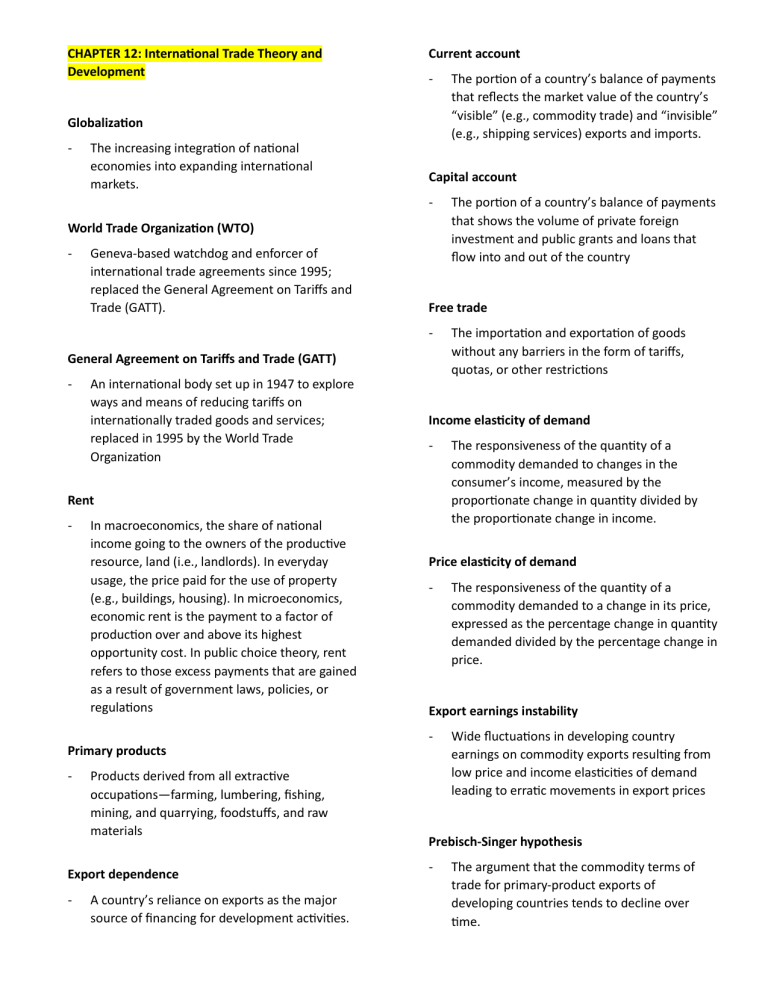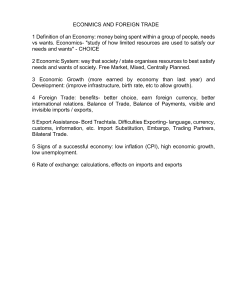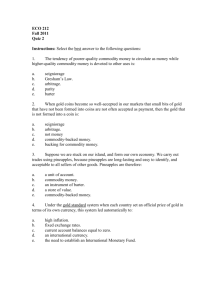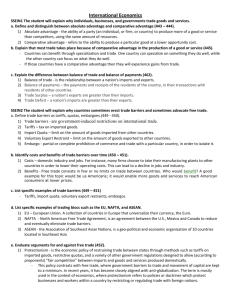
CHAPTER 12: International Trade Theory and Development Current account - Globalization - The increasing integration of national economies into expanding international markets. Capital account - World Trade Organization (WTO) - Geneva-based watchdog and enforcer of international trade agreements since 1995; replaced the General Agreement on Tariffs and Trade (GATT). General Agreement on Tariffs and Trade (GATT) An international body set up in 1947 to explore ways and means of reducing tariffs on internationally traded goods and services; replaced in 1995 by the World Trade Organization In macroeconomics, the share of national income going to the owners of the productive resource, land (i.e., landlords). In everyday usage, the price paid for the use of property (e.g., buildings, housing). In microeconomics, economic rent is the payment to a factor of production over and above its highest opportunity cost. In public choice theory, rent refers to those excess payments that are gained as a result of government laws, policies, or regulations - - Export dependence - A country’s reliance on exports as the major source of financing for development activities. The responsiveness of the quantity of a commodity demanded to a change in its price, expressed as the percentage change in quantity demanded divided by the percentage change in price. Export earnings instability - Products derived from all extractive occupations—farming, lumbering, fishing, mining, and quarrying, foodstuffs, and raw materials The responsiveness of the quantity of a commodity demanded to changes in the consumer’s income, measured by the proportionate change in quantity divided by the proportionate change in income. Price elasticity of demand Primary products - The importation and exportation of goods without any barriers in the form of tariffs, quotas, or other restrictions Income elasticity of demand Rent - The portion of a country’s balance of payments that shows the volume of private foreign investment and public grants and loans that flow into and out of the country Free trade - - The portion of a country’s balance of payments that reflects the market value of the country’s “visible” (e.g., commodity trade) and “invisible” (e.g., shipping services) exports and imports. Wide fluctuations in developing country earnings on commodity exports resulting from low price and income elasticities of demand leading to erratic movements in export prices Prebisch-Singer hypothesis - The argument that the commodity terms of trade for primary-product exports of developing countries tends to decline over time. Comparative advantage Oligopolistic market control - - Production of a commodity at a lower opportunity cost than any of the alternative commodities that could be produced. A situation in which a small number of rival but not necessarily competing firms dominate an industry. Specialization Increasing returns - - Concentration of resources in the production of relatively few commodities Factor endowment trade theory - The neoclassical model of free trade, which postulates that countries will tend to specialize in the production of the commodities that make use of their abundant factors of production (land, labor, capital, etc.) A disproportionate increase in output that results from a change in the scale of production. Product differentiation Attempts by producers to distinguish their product from similar ones through advertising or minor design changes. Risk - A situation in which the probabilities of the various possible outcomes are known, but the actual outcome is not known. North-South trade models - Trade and development theories that focus on the unequal exchange between the North developed countries and the South developing countries in an attempt to explain why the South gains less from trade than the North Uncertainty - A situation in which neither the actual outcome nor even the precise probabilities of the various possible outcomes are known Growth poles Vent-for-surplus theory of international trade - The contention that opening world markets to developing countries through international trade allows those countries to make better use of formerly underutilized land and labor resources so as to produce larger primaryproduct outputs, the surpluses of which can be exported - Industrial policy - Returns to scale - How much output expands when all inputs are proportionately increased. Monopolistic market control - A situation in which the output of an industry is controlled by a single producer (or seller) or by a group of producers who make joint decisions. Regions that are more economically and socially advanced than others around them, such as urban centers versus rural areas or highway corridors in developing countries. Deliberate effort by governments to guide the market by coordinating and supporting specific industrial activities Tariff - A fixed-percentage tax on the value of an imported commodity levied at the point of entry into the importing country. Quota - In international trade, a physical limitation on the quantity of any item that can be imported into a country. Subsidy Import substitution - - A payment by the government to producers or distributors in an industry for such purposes as preventing the decline of that industry, expanding employment, increasing exports, or reducing selected prices paid by consumers. Export promotion - Gains from trade - A deliberate effort to replace consumer imports by promoting the emergence and expansion of domestic industries. The increase in output and consumption resulting from specialization in production and free trade with other economic units, including persons, regions, or countries. Governmental efforts to expand the volume of a country’s exports through increasing export incentives, decreasing disincentives, and other means in order to generate more foreign exchange and improve the current account of its balance of payments or achieve other objectives. Balanced trade - A situation in which the value of a country’s exports and the value of its imports are equal International commodity agreement - Enclave economies - Small, economically developed regions in developing countries in which the remaining areas have experienced much less progress. Multifiber Arrangement (MFA) - Foreign-exchange earnings - A formal agreement by sellers of a common internationally traded commodity (e.g., coffee, sugar) to coordinate supply to maintain price stability The sum total of all foreign currency receipts less expenditures during a given fiscal year. A set of nontariff quotas established by developed countries on imports of cotton, wool, synthetic textiles, and clothing from individual developing countries Trade deficit Outward-looking development policies - Policies that encourage exports, often through the free movement of capital, workers, enterprises, and students; a welcome to multinational corporations; and open communications. - An excess of import expenditures over export receipts measured on the current account Infant industry - A newly established industry, usually protected by a tariff barrier as part of a policy of import substitution Inward-looking development policies - Policies that stress economic self-reliance on the part of developing countries, including domestic development of technology, the imposition of barriers to imports, and the discouragement of private foreign investment. Official exchange rate - Rate at which the central bank will buy and sell the domestic currency in terms of a foreign currency such as the U.S. dollar. Free-market exchange rate - Rate determined solely by international supply and demand for domestic currency expressed in terms of, say, U.S. dollars. second, illegal (or freely floating) rate for imported consumption goods. Devaluation - Overvalued exchange rate - An official exchange rate set at a level higher than its real or shadow value Depreciation (of currency) - Nontariff trade barrier - A barrier to free trade that takes a form other than a tariff, such as quotas or (possibly arbitrary) sanitary requirements. An ad valorem percentage tariff levied on imports. Effective rate of protection - The degree of protection on value added as opposed to the final price of an imported product—usually higher than the nominal rate of protection. The decline over time in the value or price of one currency in terms of another as a result of market forces of supply and demand. Flexible exchange rate Nominal rate of protection - A lowering of the official exchange rate between one country’s currency and all other currencies The exchange value of a national currency that is free to move up and down in response to shifts in demand and supply arising from international trade and finance. Managed float - A fluctuating exchange rate that allows central bank intervention to reduce erratic currency fluctuation Wage-price spiral Value added - - Amount of a product’s final value that is added at each stage of production A vicious cycle in which higher consumer prices (e.g., as a result of devaluation) cause workers to demand higher wages, which in turn cause producers to raise prices and worsen inflationary forces. Exchange control - A governmental policy designed to restrict the outflow of domestic currency and prevent a worsened balance of payments position by controlling the amount of foreign exchange that can be obtained or held by domestic citizens. Undervalued exchange rate - Trade optimists - Dual exchange rate (parallel exchange rate) - Foreign-exchange-rate system with a highly overvalued and legally fixed rate applied to capital and intermediate-goods imports and a An official exchange rate set at a level lower than its real or shadow value Theorists who believe in the benefits of free trade, open economies, and outward-looking development policies. Trade pessimists Customs union - - Theorists who argue that without tariff protection or quantitative restrictions on trade, developing countries gain little or nothing from an export oriented, open-economy posture. A form of economic integration in which two or more nations agree to free all internal trade while levying a common external tariff on all nonmember countries. New protectionism Free-trade area - - The erection of various nontariff trade barriers by developed countries against the manufactured exports of developing nations A form of economic integration in which free trade exists among member countries, but members are free to levy tariffs on nonmember countries. Trade liberalization - Removal of obstacles to free trade, such as quotas, nominal and effective rates of protection, and exchange controls. Common market - A form of economic integration in which there is free internal trade, a common tariff, and the free movement of labor and capital among partner states. Industrialization strategy approach - A school of thought in trade and development that emphasizes the importance of overcoming market failures through government policy to encourage technology transfer and exports of progressively more advanced products. Autarky - A closed economy that attempts to be completely self-reliant. Trade creation Economic integration - - The merging to various degrees of the economies and economic policies of two or more countries in a region. Shift, upon formation of a customs union, in the location of production from higher-cost to lower-cost member states. Trade diversion Economic union - - The full integration of two or more economies into a single economic entity. Shift, upon formation of a customs union, of the location of production of formerly imported goods from a lower-cost nonmember state to a higher-cost member nation Regional trading bloc - An economic coalition among countries within a geographic region, usually characterized by liberalized internal trade and uniform restrictions on external trade, designed to promote regional economic integration and growth. Uruguay Round - A round of the General Agreement on Tariffs and Trade negotiations, started in Uruguay in 1986 and signed in 1994, designed to promote international free trade






